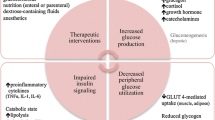Abstract
Background
Studies have suggested that both the degree and the duration of hyperglycemia are independent risk factors for adverse outcome both in pediatric anesthesia and in critically ill children. In a recent paper, we combined intraoperative glycemic variations and length of surgery creating a metabolic glucose-related stress index called “Glycemic Stress Index” (GSI).
Aim
To validate GSI for predicting PICU stay in a population of children undergoing different major neurosurgical procedures.
Methods
A total of 352 patients with craniotomy were enrolled. Basic clinical data and PICU length of stay were recorded real time. Intraoperative blood loss has been determined considering the estimated red cell volume loss ratio. GSI was calculated and subjected to ROC analysis having as targets PICU length of stay >100 or >200 h.
Results
The overall mean PICU stay was 35 h. Correlation analysis confirmed a low but highly significant direct correlation between GSI and PICU length of stay. ROC analysis showed an area under the ROC curve (AUC) of 0.74 (p = 0.03) for GSI to predict PICU stay >200 h and an AUC of 0.67 (p = 0.01) to predict PICU stay >100 h. Best predictive cutoff values were 4.5 and 3.9, for PICU stay >200 and >100 h, respectively. Overall accuracy for the test is higher in predicting PICU stay >200 h.
Conclusions
GSI significantly predicts prolonged PICU stay after major neurosurgery in a mixed population of children affected by different neurosurgical conditions.

Similar content being viewed by others
References
Rake AJ, Srinivasan V, Nakdarni V, Kaptan R, Newth CJL. Glucose variability and survival in critically ill children: allostasis or harm? Pediatr Crit Care Med. 2011;11:707–12.
van den Heuvel I, Vlasselaers D. Clinical benefits of tigh glycaemic conol: focus on the paediatric patient. Best Pract Res Clin Anaestheiol. 2009;23:441–8.
Polito A, Thiagarajan RR, Laussen PC, Gauvreau K, Agus MSD, Scheurer MA, Pigula FA, Costello GM. Association between intraoperative and early postoperative glucose levels and adverse outcomes after complex congenital hearth surgery. Circulation. 2008;118:2235–42.
Srinivasan V, Spinella P, Drott HR. Association of timing, duration and intensity of hyperglycemia with intensive care unit mortality in critically ill children. Pediatr Crit Care Med. 2004;5:329–36.
Pietrini D, Di Rocco C, Di Bartolomeo R, Conti G, Ranelletti FO, De Luca D, Tosi F, Mensi S, D’Arrigo S, Piastra M. No-glucose strategy influences posterior cranial fossa tumours postoperative course: introducing the glycemic stress index. J Neurooncol. 2009;93:361–8.
Di Rocco C, Tamburrini G, Pietrini D. Blood sparing in craniosynostosis surgery. Semin Pediatr Neurol. 2004;11:278–87.
Piastra M, Di Rocco C, Caresta E, Zorzi G, De Luca D, Caldarelli M, La Torre G, Conti G, Antonelli M, Eaton S, Pietrini D. Blood Loss and short-term outcome of infants undergoing brain tumour removal. J Neurooncol. 2008;90:191–200.
Kearney RA, Rosales JK, Howes WJ. Craniosynostosis: an assessment of blood loss and transfusion practices. Can J Anaesth. 1989;36:473–7.
O’Shaughnessy DF, Atterbury C, Bolton Maggs P, Murphy M, Thomas D, Yates S, Williamson LM, British Committee for Standards in Haematology, Blood Transfusion Task Force. Guidelines for the use of fresh-frozen plasma, cryoprecipitate and cryosupernatant. Br J Haematol. 2004;126:11–28.
Rake AJ, Srinivasan V, Nadkarni V, Kaptan R. Glucose variability and survival in critically ill children: allostasis or harm? Pediatr Crit Care Med. 2010;11:707–12.
Moga M, Manlhiot C, Marwali EM, McCrindle BW, Van Arsdell GS, Schwartz SM. Hyperglycemia after pediatric cardiac surgery: impact of age and residual lesions. Crit Care Med. 2011;39:266–72.
Aleksic V, Radulovic D, Milakovic B, Nagulic M, Vucovic D, Antunovic V, Djordjevic M. A retrospective analysis of anesthesiologic complications in pediatric neurosurgery. Pediatr Anesth. 2009;19:879–86.
Naghib S, van der Starre C, Gischler SJ, Joosten KF, Tibboel D. Mortality in very long stay pediatric intensive care unit patients and incidence of withdrawal of treatment. Intensive Care Med. 2010;36:131–6.
Fernandez de Sevilla Estrach M, Cambra Lasaosa FJ, Segura Matute S, Guillen Quesada A, Palomeque Rico A. Pediatric intensive care after brain tumor surgery. An Pediatr (Barc). 2009;70:282–6.
Spentzas T, Escue JE, Patters AB, Varelas PN. Brain tumor resection in children: neurointensive care unit course and resource utilization. Pediatr Crit Care Med. 2010;11:718–22.
Cock OJ, Ockzose Z, Pasaoglu H, Yardim S. Glucose response during craniotomy: propofol-remifentanil vs isoflurane-remifentanil. Min Anestesiol. 2011;77:1–2.
Bell MJ, Carpenter J, Au AK, Keating RF, Myseros JS, Yaun A, Weinstein S. Development of a pediatric neurocritical care service. Neurocrit Care. 2009;10:4–10.
Kochanek PM, Tasker R. Pediatric neurointensive care 2008 update for the Rogers’ Textbook of Pediatric Intensive Care. Pediatr Crit Care Med. 2009;10:517–23.
Kelly DF. Neurosurgical postoperative care. Neurosurg Clin N Am. 1994;5:789–810.
Acknowledgments
The study was funded by departmental resources.
Author information
Authors and Affiliations
Corresponding author
Ethics declarations
Conflict of interest
None of the authors had conflicts of interest to disclose.
Informed Consent
The Ethical Committee approved the study and waived the need for informed consent.
Rights and permissions
About this article
Cite this article
Piastra, M., Pizza, A., Tosi, F. et al. Validation of the Glycemic Stress Index in Pediatric Neurosurgical Intensive Care. Neurocrit Care 26, 388–392 (2017). https://doi.org/10.1007/s12028-016-0344-9
Published:
Issue Date:
DOI: https://doi.org/10.1007/s12028-016-0344-9




